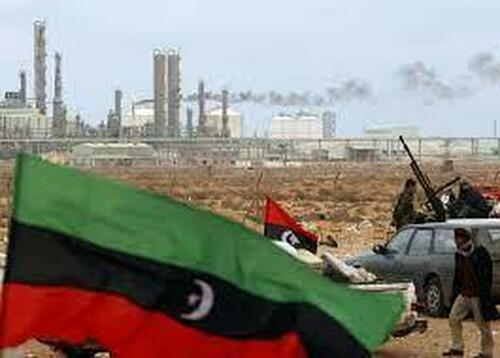
Authored by Simon Watkins via OilPrice.com,
-
The relentless oil price is causing economic havoc around the world, and Libya represents a major supply risk that could send prices even higher.
-
The recent failed attempt by Bashagha to take power in Tripoli has heightened tensions in the country and could lead to significant supply outages.
-
Until there is genuine progress on the issue of fair distribution of oil revenues within the country, this risk of major supply outages will continue to plague markets.
The economic pain for many countries being caused by still-high crude oil (and gas) prices may be exacerbated by another extensive series of blockades of key oil facilities in Libya.
This follows the very recent failed attempt by Fathi Bashagha – appointed prime minister of the ‘alternative government’ in the east of the country three months ago – to take over power in Tripoli. Bashagha, and the Nawasi Brigade militia who accompanied him, were eventually driven out of the city by various other of many factions fighting there. This occurred amid the ongoing refusal of the Government of National Unity’s (GNU) Prime Minister, Abdul Hamid Dbeibah - who was appointed through a United Nations (U.N.)-led process in 2021 - to hand over power until such a time as a properly elected government is voted into office by the people of Libya. Bashagha, who has led three such coup attempts in three months, is unlikely to stop his current attempts to seize power, given the distinct possibility that talks held in Egypt at the behest of U.N. envoy Stephanie Williams to reach an agreement on a new constitutional framework and a timeline for elections might see him sidelined. Even if Bashagha is successfully removed from any legal or quasi-legal basis of power and accepts the decision, the fault lines that run through Libya, and permeate into its oil sector, are too deep and broad to just disappear with him.
Since the removal of long-time leader, Muammar Gaddafi, in 2011, as analyzed in-depth in my new book on the global oil markets, the multi-factional civil conflict that has ensued found genuine relief only in the September 2020 agreement signed between Khalifa Haftar, the commander of the rebel Libyan National Army (LNA), and elements of Tripoli’s U.N.-recognised Government of National Accord (GNA). However, even back then, a key part of this deal was an in-principle agreement to look into establishing a commission not only to determine how oil revenues across Libya are distributed but also to consider the implementation of a number of measures designed to stabilize the country’s perilous financial position. Just prior to the September 2020 agreement, there had been yet another series of long-running oil blockades that had cost the country an estimated US$9.8 billion in lost hydrocarbon revenues.
Both before this 2020 agreement and after it began to break down, Libya’s oil sector has been subject to various-scale blockades of its key oil facilities, and even now around half or slightly more of Libya’s oil production is offline, according to various estimates. Prior to this, following the National Oil Company (NOC) declaring a legal state of ‘force majeure’ because “it is impossible to implement its commitments towards the oil market,” Libyan crude oil production had seen an extended loss of around 550,000 bpd of its oil production as a result of blockades on major fields and export terminals. These included the closure of the Zueitina port, whose crude loadings average around 90,000 bpd, with production also stopped at Abuatufol, Al-Intisar, Anakhla, and Nafura. Just prior to this, the Sharara field in the west of the country, which can pump around 300,000 bpd, was also shut down, and just prior to this the El Feel oil field, which produces 70,000 bpd, was closed, as was the 60,000 bpd Brega operation. These sites are key suppliers of mostly high-quality light, sweet crude oil, notably including the Es Sider and Sharara export crudes.
It is easy to forget that before Gaddafi’s removal in 2011, Libya had been easily able to produce around 1.65 million bpd of mostly high-quality light, sweet crude oil. Production had additionally been on a rising production trajectory, up from about 1.4 million bpd in 2000, albeit well below the peak levels of more than 3 million bpd achieved in the late 1960s. This said, the NOC had plans in place before 2011 to roll out enhanced oil recovery (EOR) techniques to increase crude oil production at maturing oil fields. Even up until the most recent major production blockades of its western fields and eastern ports ended, Libya had been producing around 1.2 million bpd. From that level, there still appeared scope to increase this to the 2.1 million bpd targeted by Libya’s Oil Ministry, and to hit the informal interim targets of 1.45 million bpd by the end of 2022, and 1.6 million bpd by the end of 2023. It is apposite to remember at this point that Libya still has around 48 billion barrels of proved crude oil reserves – the largest in Africa.
Given this potential, there was, and to some degree still is, the prospect of major international participation in Libya’s oil sector. Earlier this year, the Oil Ministry had begun discussing exploration and development options with several international oil companies, with an agreement of sorts being struck with TotalEnergies. This saw the French firm commit to continue with its efforts to increase oil production from the giant Waha, Sharara, Mabruk, and Al Jurf oil fields by at least 175,000 bpd and to make the development of the Waha-concession North Gialo and NC-98 oil fields a priority, according to the NOC. The Waha concessions – in which TotalEnergies took a minority stake in 2019 – have the capacity to produce at least 350,000 bpd together, according to the NOC. The second deal was the approval by Libya’s GNU of the sale of the 8.16 percent stake in the country’s giant Waha oil concessions held by the U.S.’s Hess Corporation to the remaining stakeholders – again, TotalEnergies (with a 16.3 percent share), and also ConocoPhillips (also 16.3 percent), each of which was offered first refusal on half of Hess’s stake.
At the core of Libya’s short-, medium-, and long-term crude oil production outlook, though, and again reiterated behind the scenes in the very recent Cairo talks by the U.S., is that there must be genuine progress on the issue of fair distribution of oil revenues, the promise of which had successfully underpinned the 2020 agreement for longer than anyone expected.
According to a Washington-based legal source spoken to by OilPrice.com at the time of the September 2020 agreement and reiterated recently, the NOC had been working on “alternative banking arrangements for the oil revenues that may or may not involve the input on final dispersal of more players.”
Part of this process would be the creation of technical committees with representatives drawn from all sides of the civil conflict.
These separate committees would deal with field awards, in tandem with the oil and gas ministry, and the dispersal of oil and gas revenues, in tandem with the ministry and the Central Bank of Libya (in which the revenues are physically held). As it stands, neither the GNA nor the Central Bank of Libya has publically and unequivocally agreed to its core principles as yet, and during the last major series of blockades of Libya’s oil infrastructure, the U.S. ambassador to Libya, Richard Norland, urged the country’s central bank to safeguard oil revenue from misappropriation.
Authored by Simon Watkins via OilPrice.com,
-
The relentless oil price is causing economic havoc around the world, and Libya represents a major supply risk that could send prices even higher.
-
The recent failed attempt by Bashagha to take power in Tripoli has heightened tensions in the country and could lead to significant supply outages.
-
Until there is genuine progress on the issue of fair distribution of oil revenues within the country, this risk of major supply outages will continue to plague markets.
The economic pain for many countries being caused by still-high crude oil (and gas) prices may be exacerbated by another extensive series of blockades of key oil facilities in Libya.
This follows the very recent failed attempt by Fathi Bashagha – appointed prime minister of the ‘alternative government’ in the east of the country three months ago – to take over power in Tripoli. Bashagha, and the Nawasi Brigade militia who accompanied him, were eventually driven out of the city by various other of many factions fighting there. This occurred amid the ongoing refusal of the Government of National Unity’s (GNU) Prime Minister, Abdul Hamid Dbeibah – who was appointed through a United Nations (U.N.)-led process in 2021 – to hand over power until such a time as a properly elected government is voted into office by the people of Libya. Bashagha, who has led three such coup attempts in three months, is unlikely to stop his current attempts to seize power, given the distinct possibility that talks held in Egypt at the behest of U.N. envoy Stephanie Williams to reach an agreement on a new constitutional framework and a timeline for elections might see him sidelined. Even if Bashagha is successfully removed from any legal or quasi-legal basis of power and accepts the decision, the fault lines that run through Libya, and permeate into its oil sector, are too deep and broad to just disappear with him.
Since the removal of long-time leader, Muammar Gaddafi, in 2011, as analyzed in-depth in my new book on the global oil markets, the multi-factional civil conflict that has ensued found genuine relief only in the September 2020 agreement signed between Khalifa Haftar, the commander of the rebel Libyan National Army (LNA), and elements of Tripoli’s U.N.-recognised Government of National Accord (GNA). However, even back then, a key part of this deal was an in-principle agreement to look into establishing a commission not only to determine how oil revenues across Libya are distributed but also to consider the implementation of a number of measures designed to stabilize the country’s perilous financial position. Just prior to the September 2020 agreement, there had been yet another series of long-running oil blockades that had cost the country an estimated US$9.8 billion in lost hydrocarbon revenues.
Both before this 2020 agreement and after it began to break down, Libya’s oil sector has been subject to various-scale blockades of its key oil facilities, and even now around half or slightly more of Libya’s oil production is offline, according to various estimates. Prior to this, following the National Oil Company (NOC) declaring a legal state of ‘force majeure’ because “it is impossible to implement its commitments towards the oil market,” Libyan crude oil production had seen an extended loss of around 550,000 bpd of its oil production as a result of blockades on major fields and export terminals. These included the closure of the Zueitina port, whose crude loadings average around 90,000 bpd, with production also stopped at Abuatufol, Al-Intisar, Anakhla, and Nafura. Just prior to this, the Sharara field in the west of the country, which can pump around 300,000 bpd, was also shut down, and just prior to this the El Feel oil field, which produces 70,000 bpd, was closed, as was the 60,000 bpd Brega operation. These sites are key suppliers of mostly high-quality light, sweet crude oil, notably including the Es Sider and Sharara export crudes.
It is easy to forget that before Gaddafi’s removal in 2011, Libya had been easily able to produce around 1.65 million bpd of mostly high-quality light, sweet crude oil. Production had additionally been on a rising production trajectory, up from about 1.4 million bpd in 2000, albeit well below the peak levels of more than 3 million bpd achieved in the late 1960s. This said, the NOC had plans in place before 2011 to roll out enhanced oil recovery (EOR) techniques to increase crude oil production at maturing oil fields. Even up until the most recent major production blockades of its western fields and eastern ports ended, Libya had been producing around 1.2 million bpd. From that level, there still appeared scope to increase this to the 2.1 million bpd targeted by Libya’s Oil Ministry, and to hit the informal interim targets of 1.45 million bpd by the end of 2022, and 1.6 million bpd by the end of 2023. It is apposite to remember at this point that Libya still has around 48 billion barrels of proved crude oil reserves – the largest in Africa.
Given this potential, there was, and to some degree still is, the prospect of major international participation in Libya’s oil sector. Earlier this year, the Oil Ministry had begun discussing exploration and development options with several international oil companies, with an agreement of sorts being struck with TotalEnergies. This saw the French firm commit to continue with its efforts to increase oil production from the giant Waha, Sharara, Mabruk, and Al Jurf oil fields by at least 175,000 bpd and to make the development of the Waha-concession North Gialo and NC-98 oil fields a priority, according to the NOC. The Waha concessions – in which TotalEnergies took a minority stake in 2019 – have the capacity to produce at least 350,000 bpd together, according to the NOC. The second deal was the approval by Libya’s GNU of the sale of the 8.16 percent stake in the country’s giant Waha oil concessions held by the U.S.’s Hess Corporation to the remaining stakeholders – again, TotalEnergies (with a 16.3 percent share), and also ConocoPhillips (also 16.3 percent), each of which was offered first refusal on half of Hess’s stake.
At the core of Libya’s short-, medium-, and long-term crude oil production outlook, though, and again reiterated behind the scenes in the very recent Cairo talks by the U.S., is that there must be genuine progress on the issue of fair distribution of oil revenues, the promise of which had successfully underpinned the 2020 agreement for longer than anyone expected.
According to a Washington-based legal source spoken to by OilPrice.com at the time of the September 2020 agreement and reiterated recently, the NOC had been working on “alternative banking arrangements for the oil revenues that may or may not involve the input on final dispersal of more players.”
Part of this process would be the creation of technical committees with representatives drawn from all sides of the civil conflict.
These separate committees would deal with field awards, in tandem with the oil and gas ministry, and the dispersal of oil and gas revenues, in tandem with the ministry and the Central Bank of Libya (in which the revenues are physically held). As it stands, neither the GNA nor the Central Bank of Libya has publically and unequivocally agreed to its core principles as yet, and during the last major series of blockades of Libya’s oil infrastructure, the U.S. ambassador to Libya, Richard Norland, urged the country’s central bank to safeguard oil revenue from misappropriation.





